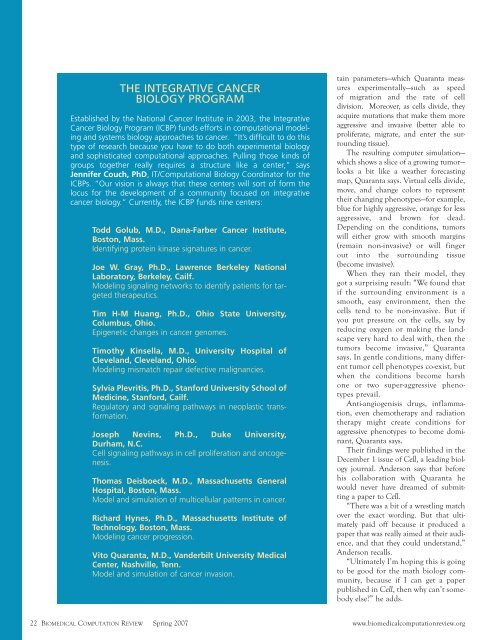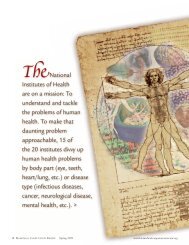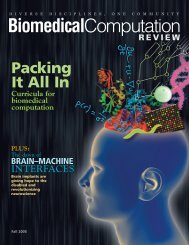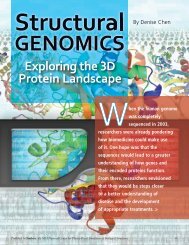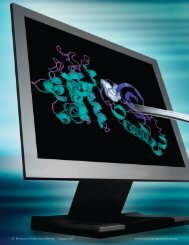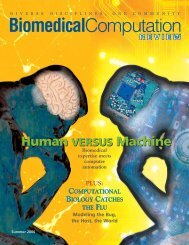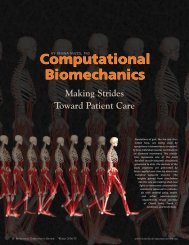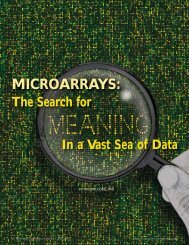Modeling Cancer Biology - Biomedical Computation Review
Modeling Cancer Biology - Biomedical Computation Review
Modeling Cancer Biology - Biomedical Computation Review
You also want an ePaper? Increase the reach of your titles
YUMPU automatically turns print PDFs into web optimized ePapers that Google loves.
THE INTEGRATIVE CANCER<br />
BIOLOGY PROGRAM<br />
Established by the National <strong>Cancer</strong> Institute in 2003, the Integrative<br />
<strong>Cancer</strong> <strong>Biology</strong> Program (ICBP) funds efforts in computational modeling<br />
and systems biology approaches to cancer. “It’s difficult to do this<br />
type of research because you have to do both experimental biology<br />
and sophisticated computational approaches. Pulling those kinds of<br />
groups together really requires a structure like a center,” says<br />
Jennifer Couch, PhD, IT/<strong>Computation</strong>al <strong>Biology</strong> Coordinator for the<br />
ICBPs. “Our vision is always that these centers will sort of form the<br />
locus for the development of a community focused on integrative<br />
cancer biology.” Currently, the ICBP funds nine centers:<br />
Todd Golub, M.D., Dana-Farber <strong>Cancer</strong> Institute,<br />
Boston, Mass.<br />
Identifying protein kinase signatures in cancer.<br />
Joe W. Gray, Ph.D., Lawrence Berkeley National<br />
Laboratory, Berkeley, Cailf.<br />
<strong>Modeling</strong> signaling networks to identify patients for targeted<br />
therapeutics.<br />
Tim H-M Huang, Ph.D., Ohio State University,<br />
Columbus, Ohio.<br />
Epigenetic changes in cancer genomes.<br />
Timothy Kinsella, M.D., University Hospital of<br />
Cleveland, Cleveland, Ohio.<br />
<strong>Modeling</strong> mismatch repair defective malignancies.<br />
Sylvia Plevritis, Ph.D., Stanford University School of<br />
Medicine, Stanford, Cailf.<br />
Regulatory and signaling pathways in neoplastic transformation.<br />
Joseph Nevins, Ph.D., Duke University,<br />
Durham, N.C.<br />
Cell signaling pathways in cell proliferation and oncogenesis.<br />
Thomas Deisboeck, M.D., Massachusetts General<br />
Hospital, Boston, Mass.<br />
Model and simulation of multicellular patterns in cancer.<br />
Richard Hynes, Ph.D., Massachusetts Institute of<br />
Technology, Boston, Mass.<br />
<strong>Modeling</strong> cancer progression.<br />
Vito Quaranta, M.D., Vanderbilt University Medical<br />
Center, Nashville, Tenn.<br />
Model and simulation of cancer invasion.<br />
tain parameters—which Quaranta measures<br />
experimentally—such as speed<br />
of migration and the rate of cell<br />
division. Moreover, as cells divide, they<br />
acquire mutations that make them more<br />
aggressive and invasive (better able to<br />
proliferate, migrate, and enter the surrounding<br />
tissue).<br />
The resulting computer simulation—<br />
which shows a slice of a growing tumor—<br />
looks a bit like a weather forecasting<br />
map, Quaranta says. Virtual cells divide,<br />
move, and change colors to represent<br />
their changing phenotypes—for example,<br />
blue for highly aggressive, orange for less<br />
aggressive, and brown for dead.<br />
Depending on the conditions, tumors<br />
will either grow with smooth margins<br />
(remain non-invasive) or will finger<br />
out into the surrounding tissue<br />
(become invasive).<br />
When they ran their model, they<br />
got a surprising result: “We found that<br />
if the surrounding environment is a<br />
smooth, easy environment, then the<br />
cells tend to be non-invasive. But if<br />
you put pressure on the cells, say by<br />
reducing oxygen or making the landscape<br />
very hard to deal with, then the<br />
tumors become invasive,” Quaranta<br />
says. In gentle conditions, many different<br />
tumor cell phenotypes co-exist, but<br />
when the conditions become harsh<br />
one or two super-aggressive phenotypes<br />
prevail.<br />
Anti-angiogenisis drugs, inflammation,<br />
even chemotherapy and radiation<br />
therapy might create conditions for<br />
aggressive phenotypes to become dominant,<br />
Quaranta says.<br />
Their findings were published in the<br />
December 1 issue of Cell, a leading biology<br />
journal. Anderson says that before<br />
his collaboration with Quaranta he<br />
would never have dreamed of submitting<br />
a paper to Cell.<br />
“There was a bit of a wrestling match<br />
over the exact wording. But that ultimately<br />
paid off because it produced a<br />
paper that was really aimed at their audience,<br />
and that they could understand,”<br />
Anderson recalls.<br />
“Ultimately I’m hoping this is going<br />
to be good for the math biology community,<br />
because if I can get a paper<br />
published in Cell, then why can’t somebody<br />
else?” he adds.<br />
22 BIOMEDICAL COMPUTATION REVIEW Spring 2007 www.biomedicalcomputationreview.org


